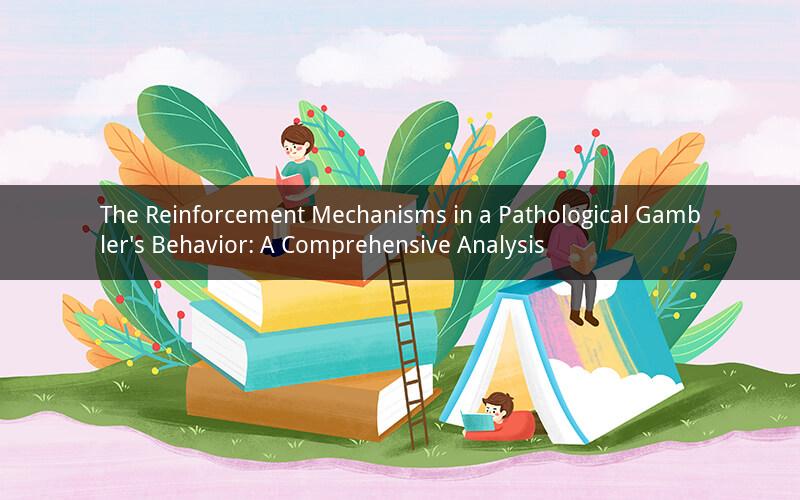
Introduction:
Pathological gambling is a complex condition that involves uncontrollable and compulsive gambling behaviors. It is characterized by an individual's inability to control their gambling activities, despite the negative consequences. One of the key factors contributing to the reinforcement of pathological gambling is the psychological and physiological mechanisms at play. This article delves into the various aspects that reinforce a pathological gambler's behavior and explores the underlying psychological processes.
1. The Role of Dopamine in Pathological Gambling:
One of the primary neurotransmitters involved in the reinforcement of pathological gambling is dopamine. Dopamine is a pleasure-inducing neurotransmitter that is released when an individual engages in rewarding activities. In pathological gamblers, the anticipation of winning and the subsequent dopamine release create a strong incentive to continue gambling. This creates a cycle of seeking out gambling activities in order to experience the same level of pleasure, leading to an increasing intensity of gambling behavior.
2. The Influence of Cognitive Biases:
Pathological gamblers often exhibit cognitive biases that reinforce their gambling behavior. These biases can include overestimation of winning chances, underestimation of the risk involved, and a focus on potential gains rather than potential losses. These cognitive biases contribute to the reinforcement of gambling activities, as individuals continue to believe that they can overcome the odds and achieve significant wins.
3. The Impact of Social and Environmental Factors:
Social and environmental factors also play a significant role in reinforcing a pathological gambler's behavior. The presence of a supportive social network that encourages gambling can provide a sense of validation and approval, further reinforcing the behavior. Additionally, the availability of gambling opportunities, such as casinos or online platforms, can increase the accessibility and convenience of gambling, making it more likely for individuals to engage in problem gambling behaviors.
4. The Role of Emotion Regulation:
Emotion regulation is another critical factor that reinforces a pathological gambler's behavior. Pathological gamblers often use gambling as a means to cope with negative emotions, such as stress, anxiety, or boredom. The temporary relief and sense of excitement that gambling provides can serve as a coping mechanism, reinforcing the behavior. This emotional reinforcement creates a strong association between gambling and the relief of negative emotions, leading to a continued engagement in gambling activities.
5. The Influence of Cognitive Control:
Cognitive control refers to the ability to regulate and control one's thoughts, emotions, and behaviors. Pathological gamblers often struggle with cognitive control, making it difficult for them to resist the urge to gamble despite negative consequences. The lack of cognitive control reinforces their gambling behavior, as they are unable to resist the诱惑和冲动的驱使。
Conclusion:
The reinforcement of a pathological gambler's behavior involves a complex interplay of neurotransmitters, cognitive biases, social and environmental factors, emotion regulation, and cognitive control. Understanding these factors is crucial in developing effective interventions and support systems for individuals struggling with pathological gambling. By addressing these underlying mechanisms, it becomes possible to break the cycle of reinforcement and promote healthier behaviors.
Questions and Answers:
1. What neurotransmitter is primarily responsible for the reinforcement of pathological gambling?
Answer: Dopamine is the primary neurotransmitter involved in the reinforcement of pathological gambling.
2. How do cognitive biases contribute to the reinforcement of gambling behavior?
Answer: Cognitive biases such as overestimation of winning chances and underestimation of risk reinforce gambling behavior by creating a false sense of optimism and a belief in the likelihood of achieving significant wins.
3. Can social and environmental factors influence a pathological gambler's behavior?
Answer: Yes, social and environmental factors such as a supportive gambling network and the availability of gambling opportunities can reinforce a pathological gambler's behavior by providing validation, convenience, and encouragement.
4. How does emotion regulation contribute to the reinforcement of pathological gambling?
Answer: Emotion regulation plays a role by using gambling as a means to cope with negative emotions, providing temporary relief and reinforcing the behavior as a coping mechanism.
5. What is the role of cognitive control in pathological gambling?
Answer: Cognitive control refers to the ability to regulate and control thoughts, emotions, and behaviors. In pathological gambling, a lack of cognitive control makes it difficult for individuals to resist the urge to gamble, thereby reinforcing their gambling behavior.